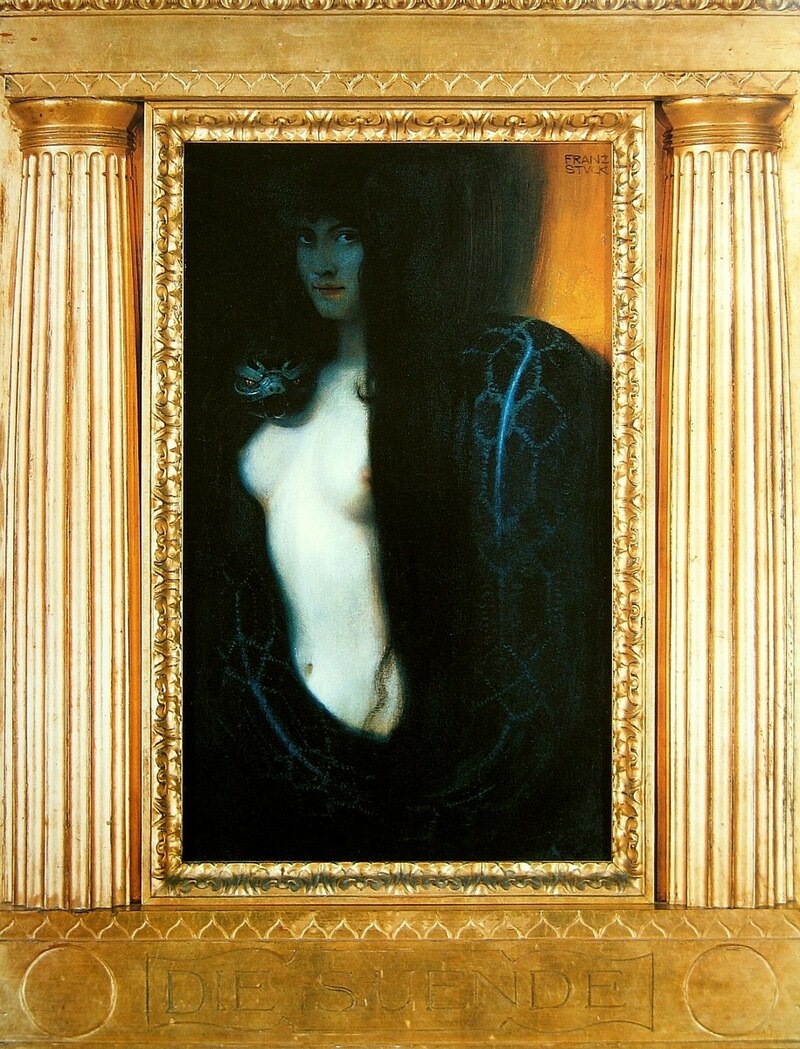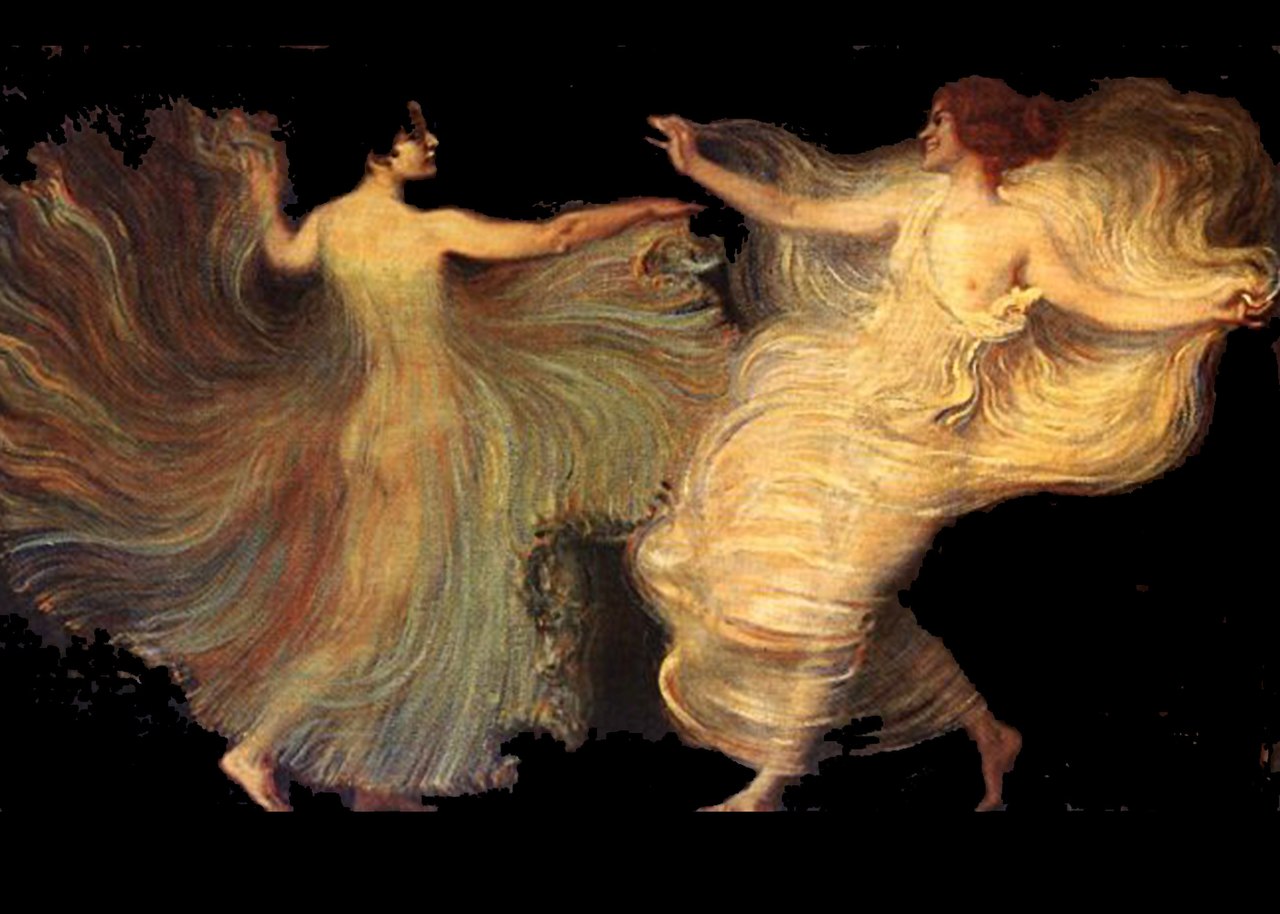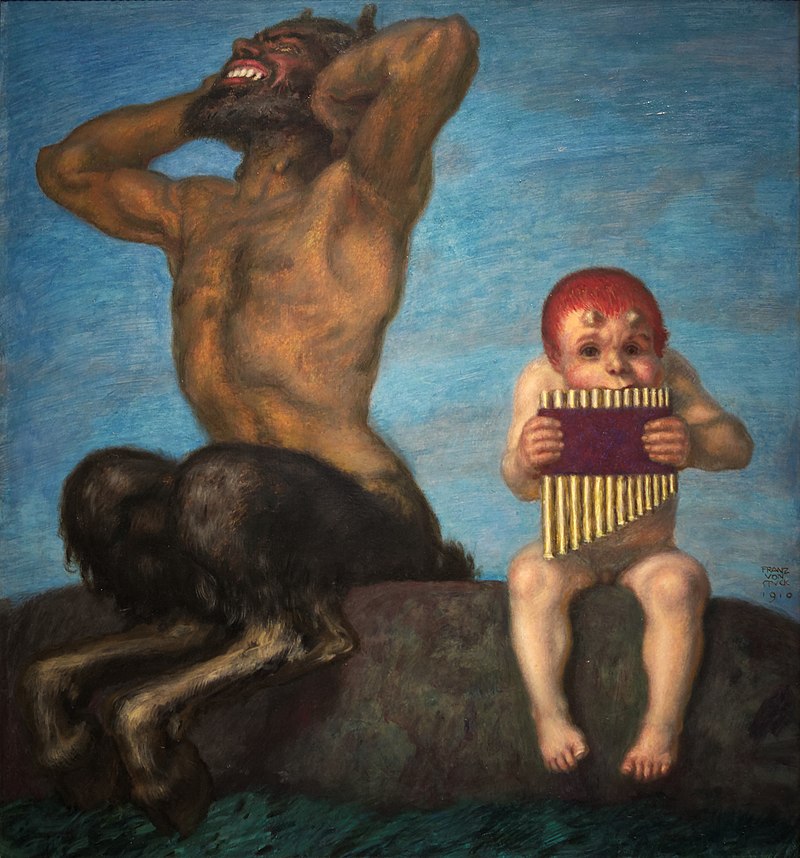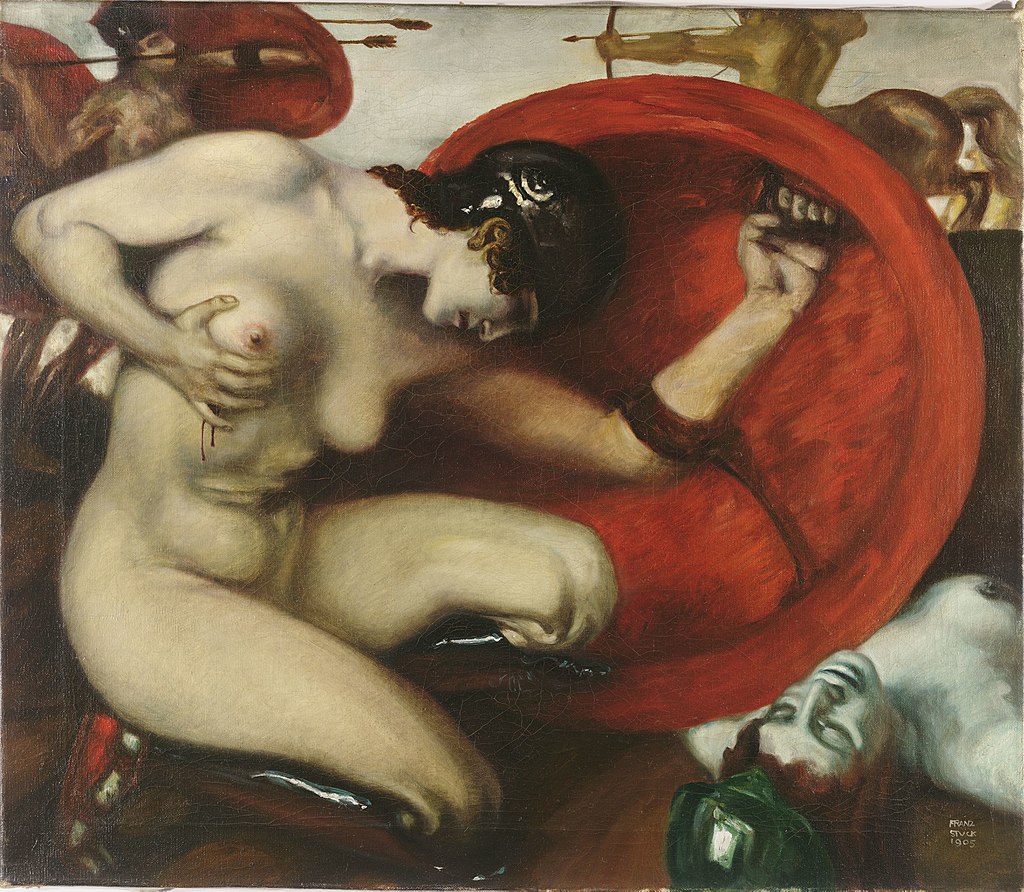47 Chapter 12 – Franz von Stuck
Art Nouveau
Kaydin Williams
Audio recording of this chapter available here:


There were many great artists throughout the nineteenth century who were known for not only perfecting their medium of choice and being the most skilled at what they did, but also for influencing future artists and their craft. One artist from Germany, however, stands out from the rest. Franz von Stuck. Franz Stuck was an influential Symbolist/Art Nouveau artist who practiced “gesamtkunstwerk, or total work of art[1]” and that is exactly the phrase that best describes him. Franz Stuck embodied art in every way he could, it wasn’t simply just his painting skills that made him such an icon, his wholistic devotion and success in such multiple areas of art is truly what made him “the last prince of art of Munich’s great days.[2]” Franz von Stuck was an icon and had even influenced people outside the world of art. Franz von Stuck was a prodigy who was able to become one of the most iconic artists to ever influence the world of art because of his early commitment to the arts at a young age, his outstanding talent in several mediums, and his patriotic admiration and self-made success.

A lot of known artists usually have some sort of mentor but Stuck did not. “Franz Stuck came from a peasant stock, and his talent as an artist was evident from an early age.[3]” His father was a miller and as soon as Stuck was able to he supported himself.[4] After his talents in drawing were noticed he went to live in Munich, where he lived the rest of his life, and where “he received his artistic training at the Academy of Applied Arts and the Academy of Fine Arts in Munich.”[5] His first jobs that he started to earn income from weren’t all that fancy, but they were still jobs in the art world. These jobs included such things as being an illustrator, making drawings or caricatures for magazines, making bookplates, menus,[6] and any other job of the sort. He needed work somehow so he turned to the everyday run of the mill artistic jobs that he could find; working for the magazine the Fliegende Blätter is where most of his early career started.[7] In 1889 when Stuck was twenty six he exhibited his first paintings, and won the gold medal, at the Munich Glass Palace exhibition.[8] The winning painting was The Guardian of Paradise. Because of Franz Stuck’s early years as a lower working artist, and having many different jobs, he was able to further hone his craft skills even more and even outside the realm of painting and drawing.
When it came to talent, Franz Stuck was a jack of all trades and a master of all. Stuck was not simply just a painter but he was also an active sculptor, printmaker, and architect.[9] In painting he was known for his close attention to describing three-dimensional forms. While Stuck won many gold medals for painting at exhibitions, he also won gold at the Paris World Exhibition in 1900 but for the furniture he made[10]; they were made for an artist’s studio and private living villa. As stated before, Franz Stuck practiced gesamtkunstwerk or total work of art and Villa Stuck embodies this perfectly. With Franz Stuck’s multiple talents focused into one area, it was bound to be a success. He put thought everywhere that he could, “life, architecture, art, music and theatre are combined[11]” all into the creation of Villa Stuck.

Even on his paintings Stuck did not simply put them into just any frame but a handmade frame made by himself for each piece; He paid such “close attention to the frames for his paintings and generally designed them himself with such careful use of panels, gilt carving and inscriptions that the frames must be taken as an integral part of the overall piece.[12]” Franz Stuck did not simply just make art but he embodied it. He added detail and looked for any amount of space he could find, in any aspect of his creations, that could somehow be altered and created into an artist’s image. When people describe a piece made by Stuck it is always no short of a sophisticated astonishment claimed to be made by a genius. “It’s marked originality of color generally, and luminosity of the flesh-tones; its aplomb, life, style; its unusual distinction of line and modeling; together with a certain sculpturesque grace of pose.[13]” As Stuck started to cross the line from rags to riches, his claim to fame was followed by enormous admiration from his people as an artist and as a German.


Franz Stuck worked for his fame, from being born a peasant, to becoming famous to the point where he was awarded nobility. “In 1905 he was awarded a Knight’s Cross of the Order of the Bavarian Throne, which raised him to the nobility, and from this point onwards he signed his works as ‘Franz von Stuck’.[14]” He was a full-fledged patriot icon for Germany. During his time alive he was very successful, he won multiple gold medals at exhibitions in more than just painting. Franz von Stuck was also a phenomenal teacher. “When only thirty-two, he was appointed professor at the Munich Academy in 1895[15]” he used his talents to give back to his country by teaching new generations of artists at the academy where he had started his career; “His notable students included Paul Klee, Hans Purrmann, Wassily Kandinsky, and Josef Albers.[16]” The number of Stuck’s pupils who went on to great success served to enhance the teacher’s own fame even further.[17]” He touched people’s heart through his story of being born into the lower end of society and being completely self-made in an American dream sense and creating his own success from the ground up. He elevated himself from famous artist into an example of ideal Germanic values. When Franz von Stuck passed away it was a big loss for the whole country “A great artist who had been a distinguished figure in international art for a generation and had done much honor to Germany had closed his career. Franz von Stuck was dead. This even, too, profoundly touched the people of Munich.[18]”

The Life of Franz von Stuck is one of rags to riches, making something from nothing. Since his early years he started learning and devoting himself in any way he could to his journey in art. He gained the recognition he deserved and was even able to become a noble; through nothing but work. He was able to succeed in so many different mediums and ideals in art as well as be able to stay true and express himself through his many creative outlets. He won multiple medals, became a professor at his academy at only thirty-two and was able to give back to his country by teaching many successful artists in the next generation. Furthermore, he ascended past just an artist and became an example of what a proud German should be. Franz von Stuck pushed the limits and set the bar higher for what it means to be a true artist.

Bibliography
Fox, William H. “Franz Von Stuck and the Bavarian Exhibition.” The Brooklyn Museum Quarterly 16, no. 1 (1929): 1-4. Accessed September 22, 2020. http://www.jstor.org/stable/26459703.
“Franz Von Stuck (1863 – 1928).” Art Experts Website, October 21, 2019. https://www.artexpertswebsite.com/artist/stuck-von/.
“Franz Von Stuck.” Franz Von Stuck – Biography & Art – The Art History Archive. Accessed September 26, 2020. http://www.arthistoryarchive.com/arthistory/symbolism/Franz-Von-Stuck.html.
“Franz Von Stuck.” Frye Art Museum. Accessed October 12, 2020. https://fryemuseum.org/exhibition/5097/.
“Franz Von Stuck.” Stephen Ongpin Fine Art. Accessed October 12, 2020. https://www.stephenongpin.com/artist/236640/franz-von-stuck.
Moran, J. W. “”Saharet,” by Franz von Stuck.” Fine Arts Journal 23, no. 1 (1910): 22-28. Accessed September 28, 2020. http://www.jstor.org/stable/23905827.
“Museum Villa Stuck.” Museum Villa Stuck: Ein Museum der Stadt München. Accessed September 26, 2020. https://www.villastuck.de/museum/index.htm.
- “Franz Von Stuck,” Frye Art Museum, Accessed October 12, 2020, https://fryemuseum.org/exhibition/5097/. ↵
- “Franz Von Stuck (1863 - 1928),” Art Experts Website, October 21, 2019, https://www.artexpertswebsite.com/artist/stuck-von/. ↵
- “Franz Von Stuck,” Stephen Ongpin Fine Art, Accessed October 12, 2020, https://www.stephenongpin.com/artist/236640/franz-von-stuck. ↵
- “Franz Von Stuck,” Stephen Ongpin Fine Art. ↵
- “Franz Von Stuck,” Stephen Ongpin Fine Art. ↵
- “Franz Von Stuck,” Stephen Ongpin Fine Art, Accessed October 12, 2020, https://www.stephenongpin.com/artist/236640/franz-von-stuck. ↵
- “Franz Von Stuck (1863 - 1928),” Art Experts Website, October 21, 2019, https://www.artexpertswebsite.com/artist/stuck-von/. ↵
- “Franz Von Stuck (1863 - 1928),” Art Experts Website. ↵
- “Franz Von Stuck,” Stephen Ongpin Fine Art, Accessed October 12, 2020, https://www.stephenongpin.com/artist/236640/franz-von-stuck. ↵
- “Museum Villa Stuck.” Museum Villa Stuck: Ein Museum der Stadt München. Accessed September 26, 2020. https://www.villastuck.de/museum/index.htm. ↵
- “Museum Villa Stuck,” Museum Villa Stuck: Ein Museum der Stadt München. ↵
- “Franz Von Stuck (1863 - 1928).” Art Experts Website, October 21, 2019. https://www.artexpertswebsite.com/artist/stuck-von/. ↵
- Moran, J. W, ""Saharet," by Franz von Stuck," Fine Arts Journal 23, no. 1 (1910): 23, http://www.jstor.org/stable/23905827. ↵
- “Franz Von Stuck,” Stephen Ongpin Fine Art, Accessed October 12, 2020, https://www.stephenongpin.com/artist/236640/franz-von-stuck. ↵
- “Franz Von Stuck,” Franz Von Stuck - Biography & Art - The Art History Archive, Accessed September 26, 2020, http://www.arthistoryarchive.com/arthistory/symbolism/Franz-Von-Stuck.html. ↵
- “Franz Von Stuck,” Franz Von Stuck - Biography & Art - The Art History Archive, Accessed September 26, 2020, http://www.arthistoryarchive.com/arthistory/symbolism/Franz-Von-Stuck.html. ↵
- “Franz Von Stuck (1863 - 1928),” Art Experts Website, October 21, 2019, https://www.artexpertswebsite.com/artist/stuck-von/. ↵
- Fox, William H, "Franz Von Stuck and the Bavarian Exhibition," The Brooklyn Museum Quarterly 16, no. 1 (1929): 1, http://www.jstor.org/stable/26459703. ↵

